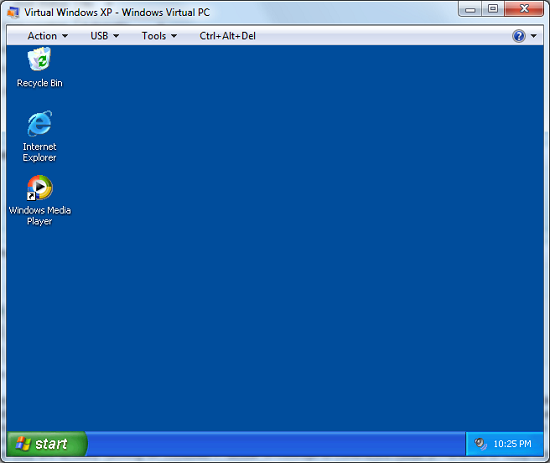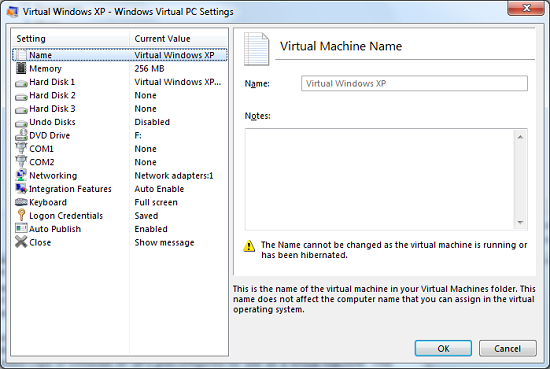Windows 7: Release Candidate 1 Preview
by Ryan Smith and Gary Key on May 5, 2009 11:00 PM EST- Posted in
- Systems
Virtual Windows XP
As we mentioned previously, Microsoft’s big secret unveiled with Windows 7 RC1 is Virtual Windows XP (VXP for short). One of the issues Microsoft has been having in bringing business users over from Win2K and XP to Vista and beyond has been that Windows does not have perfect backwards compatibility. With consumer applications this is not such a big deal since most of those are wide-audience products that get updated regularly, but this is not always the case for business software. Whether it’s some custom in-house application that no one can fix, or a 3rd party application that just works and can’t be updated, business users sometimes can’t escape the fact that they need to be able to run old applications that don’t work in newer operating systems.
VXP is in essence the bone Microsoft is throwing to business users to allow them to run those old applications while using Windows 7. VXP leverages Microsoft’s existing Virtual PC virtualization software that they acquired several years back, by bundling it with a fully licensed copy of Windows XP SP3 preconfigured for use as a virtual machine. This virtual machine can then be partially integrated in Windows 7 so that applications operating inside of it look and behave like they are actually running on Windows XP, similar in concept to the coherence mode of Parallels or Unity mode of VMware. In this case Microsoft is using RDP to connect to the virtual machine rather than screen scraping the entire desktop like Parallels and VMware do. Microsoft does the same thing for the Windows Home Server Console.

VXP Desktop View
As Virtual PC was already free, the significance of this announcement is not the technical details, but rather that Microsoft is endorsing it as an official solution to backwards compatibility problems. It’s long been expected that Microsoft would do something with Virtual PC as a backwards compatibility solution and this is finally it, albeit in a limited role.
Because of the system requirements and issues raised by relying on a virtual machine of XP, VXP is a last-ditch compatibility solution rather than any kind of primary solution. On the system requirement side, VXP requires a processor with hardware virtualization features, along with at least 256MB of RAM and the disk space needed to run the virtual machine. It’s not too bad for a modern system, but it does rule out an older system that may be suitable for upgrading to Windows 7, but not running VXP on top of that.

VXP Configuration
As for the issues raised by using VXP, first and foremost it’s a complete copy of WinXP, with all of its security deficiencies and bugs. It needs security software, it needs administration, and it needs security updates. This also brings up a matter that Microsoft hasn’t answered yet: what happens when WinXP support ends in 2014? Windows 7 will have support until at least 2020, which means either Microsoft is going to drop support for this component of Windows 7 early (an unprecedented move) or they have to extend XP support to match Windows 7’s support cycle. We’re still trying to get a final answer on this.
It should also be noted that VXP only comes with Professional edition and higher, as it’s not intended to be a consumer compatibility solution. And before anyone gets any ideas, it’s not suitable for playing games – the graphics hardware is the usual emulated S3 Trio 64, and the screen does not refresh nearly fast enough to keep up with any kind of action game. Solitaire may be playable, however.

VXP in integrated mode running IE6
At any rate, Virtual Windows XP is a good solution to some compatibility needs, so long as it’s recognized that it’s not the solution to all compatibility needs. For the handful of business users it’s designed for, we would expect that it does its intended job well. However for non-business users that absolutely must have a virtual machine (and won’t need support from Microsoft), it may be worthwhile to look into a free solution like VirtualBox.
Looking towards the future, there has been a lot of speculation that Microsoft may try to make a big break from the Windows APIs in order to clear out all the cruft and deprecated functions that litter their APIs. This isn’t happening today with Windows 7 and VXP, but integrating a virtual machine is the first stepping stone in making it happen. What Microsoft does after VXP is undoubtedly going to be a matter of great interest.










121 Comments
View All Comments
strikeback03 - Thursday, May 7, 2009 - link
In some things I can understand moving stuff, but there are also some that were moved for no good reason. For example, in XP to get display properties, you right click the desktop and click properties. In Vista there is at least one additional page to click through to get that. Ultimately, it seems to me that MS tries too hard to hide the settings, likely to protect the users who don't know what they are doing, but a pain for the users who do. For the record, I had the same complaint about XP coming from win2000, that whenever you hop on a system that wasn't set to all the classic settings, it is a pain to get around.Jackattak - Thursday, May 7, 2009 - link
But Strikeback you're talking about probably 10% of the users (power users). The majority of Windows users don't give a crap about modification, and that's who they're "protecting" based on your explanation.If you were running Microsoft, wouldn't you find it a small issue that you were "inconveniencing" 10% of your user base by making them go "one page deeper" in order to "protect" 90% of your users?
strikeback03 - Friday, May 8, 2009 - link
Then do like the GPU companies do and have both simple and advanced versions of the interface. Allow them to change one setting to show or hide all the "advanced" stuff across the OS. And put it somewhere easy to find, like the start menu.mathew7 - Wednesday, May 6, 2009 - link
I'm also a XP-lover. Even in XP I'm using it with classic view (2K view).My main problem is removal of old start-menu (cascading menus). I really hate the Vista style-menu.
Also, I prefer UAC disabled and using run-as different user. Unfortunately (in Beta), explorer would not take the new permissions (launch in separate process was enabled for both users), which means configurations had to be done with admin logon. I have not tried this yet in RC. Also, once UAC was disabled, the UAC menu items (with the shield) were still present with no actions (again I don't know about RC).
On the other hand, the new taskbar (with previews) and the multimedia settings are good-enough reason for me to switch.
ssj4Gogeta - Wednesday, May 6, 2009 - link
Start menu is one of the best features that were introduced in Vista. It's great on a netbook or a small monitor. You also don't need to move your mouse, just type in the first few letters of the app name. It also searches your documents for you.And about that RAM issue, what did you expect? I'm surprised it even runs on 512MB. Even netbooks have at least a gig of RAM.
SirKronan - Wednesday, May 6, 2009 - link
I like the revamped start menu as well. Love instant search!But did they add Blu-ray support to Media Center? This has been one of my complaints from the beginning about Media Center. It has to launch a separate program to play Blu-rays & HD DVD's, and I haven't found any way around it short of ripping the movies to a hard disk. I realize there are anti-trust/competitive laws, and I honestly don't mind having to buy PowerDVD or WinDVD to get their decoder, but I want the movie to play back in MEDIA CENTER with all of the interface's great features, like the smooth playback and intuitive controls, guide information, zoom feature (get rid of black letterbox - with 1080p you certainly have enough resolution to scale a tad!), etc.
Have they added that yet? If not, PLEASE, Anand, ask them to for us!
KingViper - Wednesday, May 6, 2009 - link
Archsoft and the newest version of PowerDVD both have plugins for Media Center..from what I hear. Although Media Center itself isn't actually playing the Blu-Ray..it looks like it integrates well. You might try out the trial versions.chrnochime - Wednesday, May 6, 2009 - link
Just because netbooks have more ram(and not every one of them has 1G, some has 512MB), doesn't mean the OS should try to gobble up as much as is available. I don't get why every iteration of their OS just keep getting bigger and bigger, with little discernible improvements to the average user.and this? "Ultimately, with Microsoft throwing Windows 7 RC1 out to the masses, we can't think of a good reason not to try it."
Unless they have ways to export the settings in programs and whatever document users have when they were using W7, it'd be really hard to convince the average user to try out just for sake of novelty.
KingViper - Wednesday, May 6, 2009 - link
"I don't get why every iteration of their OS just keep getting bigger and bigger, with little discernible improvements to the average user. "Many things an OS is responsible for is not necessarily obvious to the average user. Compatibility with almost all hardware available, including keeping the OS as secure as possible. DX10\DX11 and h264 codecs etc. etc. etc. TONS of stuff is added, but it isn't necessarily used everyday. Of course it's going to get bigger.
I don't understand how XP users are about as bitter with Microsoft as Mac users are. Can you just not afford a Mac or what?
mathew7 - Wednesday, May 6, 2009 - link
I also would like to say about W7RC and low-RAM:Windows 7 on 512MB RAM (desktop Intel G45 MB w/laptop HDD) feels to me like XP din on a 64MB RAM laptop years ago. It's good for internet/light work, but even for that you need patience because of swapping.